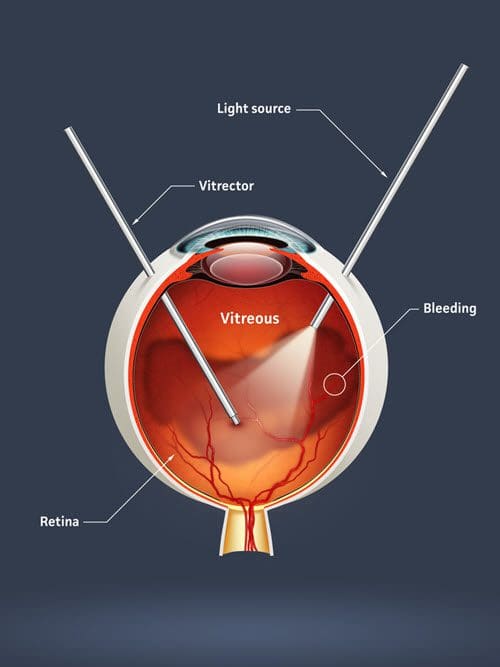Guide to Vitrectomy: Costs, Timelines & More
Last Updated:
A vitrectomy is a surgery performed on the eye to treat certain vitreous and retina conditions. Full recovery can take up to six weeks.
Table of Contents
A vitrectomy is a surgical procedure performed on the vitreous or retina. There are several reasons a doctor might recommend this procedure, such as to repair the retina or for issues like macular pucker.
Before the surgery, there are certain steps people should take to make sure they are prepared for the procedure. The doctor will give them detailed information about this to reduce the risk of complications during or after a vitrectomy.
During the surgery, the doctor may administer local or general anesthesia to promote comfort. It may take several hours to complete a vitrectomy, depending on what needs to be done.
Most people go home the same day after a short period in recovery. Knowing what to expect in the coming weeks after a vitrectomy is important. It is also imperative to know about the possible risks so people know what to look out for.
People who have medical insurance should start by determining if their surgery will be covered to help with vitrectomy surgery costs.
What Is a Vitrectomy?

There are two primary types of this procedure.
- Posterior pars plana vitrectomy: This vitrectomy type might be considered for conditions that are affecting the posterior segment, which includes the retina, choroid, sclera, and retinal pigment epithelium.
- Anterior vitrectomy: While rare, it is possible for the vitreous gel to protrude through the pupil. This can cause problems that can usually be alleviated by performing an anterior vitrectomy.
Why Do Doctors Perform a Vitrectomy?
There are several reasons a doctor might recommend a vitrectomy. It is used to:
- Remove a substance, such as blood, that is preventing light from being able to focus on the retina.
- Repair a detached retina.
- Remove scar tissue that is tearing or wrinkling the retina.
- Remove a foreign object from inside the eye.
You deserve clear vision. We can help.
With 135+ locations and over 2.5 million procedures performed, our board-certified eye surgeons deliver results you can trust.
Your journey to better vision starts here.
Certain conditions may benefit from this surgical procedure. These include:
- Diabetic retinopathy, with scar tissue or bleeding affecting the vitreous gel or retina.
- Macular hole.
- Endophthalmitis, which is a type of eye infection.
- Cataract surgery complications.
- Certain types of retinal detachment.
- Macular pucker.
- Severe eye injury.

Preparing for a Vitrectomy
The doctor will discuss all preparation instructions that must be followed before the surgery. Certain medications may need to be stopped temporarily. People might also be advised to not drink or eat the night before the procedure.
The doctor may want to examine the retina before the procedure. This typically involves dilating the pupils so they can see the retina better. In some cases, the doctor may ultrasound the eye to get a better look at the retina.
The Vitrectomy Procedure
Some people are given general anesthesia so they sleep through the surgery. In other cases, the doctor may numb the eye and give the person medicine that allows them to relax.
The type of anesthesia used depends on what needs to be done during the procedure. In most cases, people are only numbed and given a relaxing medication.
The first step is making an incision into the sclera. The exact steps used depend on the purpose of the procedure. The steps may include:
- Remove vitreous that is cloudy.
- Remove any cataracts that are present.
- Move the retina so it is placed into its proper position.
- Insert a gas or air bubble to ensure that the retina stays in its proper place.
- Remove any scar tissue that has developed on the retina.
- Remove any foreign object that is lodged in the eye.
- Repair a torn retina using a laser.
- Insert a silicone bubble to keep the retina in its proper place.
Before the surgery, the doctor will describe what needs to be done to repair or correct the abnormalities the person is experiencing. All of the above is not done during a single procedure. The doctor will determine which of the above steps are necessary.
During the procedure, there are different tools the doctor may use. Examples include a microscope, a laser, or a scalpel.
For some surgeries, the procedure is completed in about an hour. However, it is possible for certain vitrectomies to take several hours to complete. The doctor usually gives a time estimate during the pre-surgical consultation part of the process.
Vitrectomy Recovery

After the procedure, people go to recovery. Most people go home the same day and only spend a short time in recovery.
Patients should not drive themselves home because the procedure may temporarily alter vision, and the medications used could cause fatigue.
The doctor will provide detailed recovery instructions that the patient must follow. For example, the doctor may have someone use antibiotic eye drops for a short period to reduce their risk of infection. Pain medications might also be recommended and should be taken according to the doctor’s instructions.
For a day or so, people might need to wear an eye patch on the eye the vitrectomy was performed on. This patch should not be removed prematurely.
It is possible to have some soreness after the procedure. This is usually not significant and will reduce over the course of a few days.
If the doctor used any bubbles during the procedure, there are usually special instructions the person must follow. People usually need to be mindful of their movements and stay in certain positions. Exactly how long this is necessary is something the doctor will discuss with the patient before they go home.
It is imperative to not travel by air if a bubble was used. The size of the bubble can change with the rapid altitude changes that occur when people fly in an airplane.
The doctor will schedule a follow-up visit to see how the person is recovering. During this appointment, they will examine the person to determine if the procedure was a success. If a silicone bubble was put into the eye during the surgery, an additional appointment might be necessary to remove it.
It is possible to not have completely normal vision after this surgery. If any permanent damage affected the retina, this is more likely.
You deserve clear vision. We can help.
With 135+ locations and over 2.5 million procedures performed, our board-certified eye surgeons deliver results you can trust.
Your journey to better vision starts here.
Possible Risks of a Vitrectomy
There are a few complications and risks associated with a vitrectomy that people should know about.
- Retinal detachment or tearing
- Infection
- Too much scar tissue forming in the eye
- Blindness
- Bleeding in the eye
- Anesthesia-related complications, such as stroke or pneumonia
- Reduced vision
If the retina damage requires extensive repair, the risk of complications is higher. For the most part, this procedure is low risk.
The risk of serious complications is low, says the American Society of Retina Specialists, and the success rate for the surgery stands at 90 percent or better.
The doctor will provide details about the potential risks before the procedure and talk about how to look out for them during recovery.

Average Vitrectomy Surgery Cost
The cost of a vitrectomy depends on multiple factors, such as the surgeon, the type of anesthesia used, and whether someone is using insurance.
A person’s specific insurance plan plays a role in the total vitrectomy surgery cost. In the United States, the estimated national average cost of a vitrectomy is $13,731.
In 2018, research was published in Clinical Ophthalmology regarding the cost difference for a vitrectomy when someone used general anesthesia versus local anesthesia. The cost under local anesthesia was about half the cost under general anesthesia.
Before having a vitrectomy, people should learn the facts. This ensures that they know what to expect and why the doctor recommended this procedure. Ask any questions you have about the recovery timeline and the average vitrectomy surgery cost to ensure you are well prepared.
You deserve clear vision. We can help.
With 135+ locations and over 2.5 million procedures performed, our board-certified eye surgeons deliver results you can trust.
Your journey to better vision starts here.
References
- Vitrectomy. American Society of Retina Specialists.
- Vitrectomy. MD Save.
- Cost Analysis of Vitrectomy Under Local Versus General Anesthesia in a Developing Country. Clinical Ophthalmology.
- What Happens During a Vitrectomy? American Academy of Ophthalmology.
- Can I Fly With This Eye? American Academy of Ophthalmology.
- Vitrectomy. Johns Hopkins Medicine.
- Vitrectomy. Healthline.n
This content is for informational purposes only. It may have been reviewed by a licensed physician, but is not intended to serve as a substitute for professional medical advice. Always consult your healthcare provider with any health concerns. For more, read our Privacy Policy and Editorial Policy.
